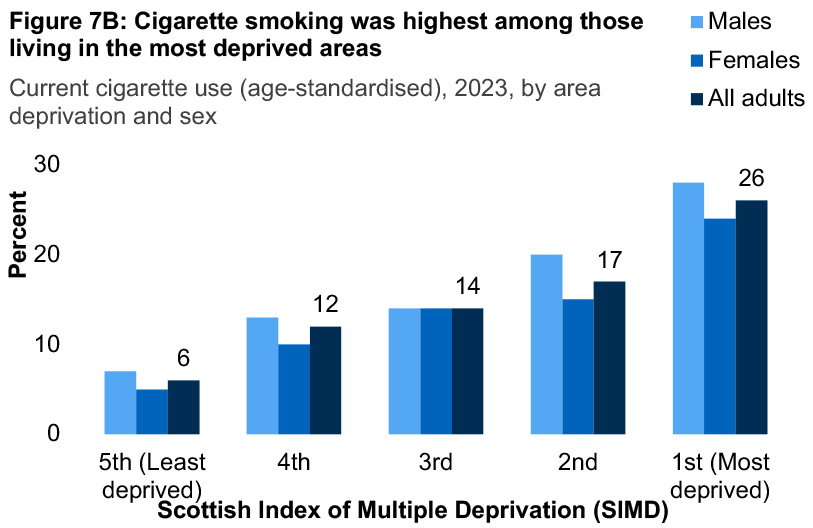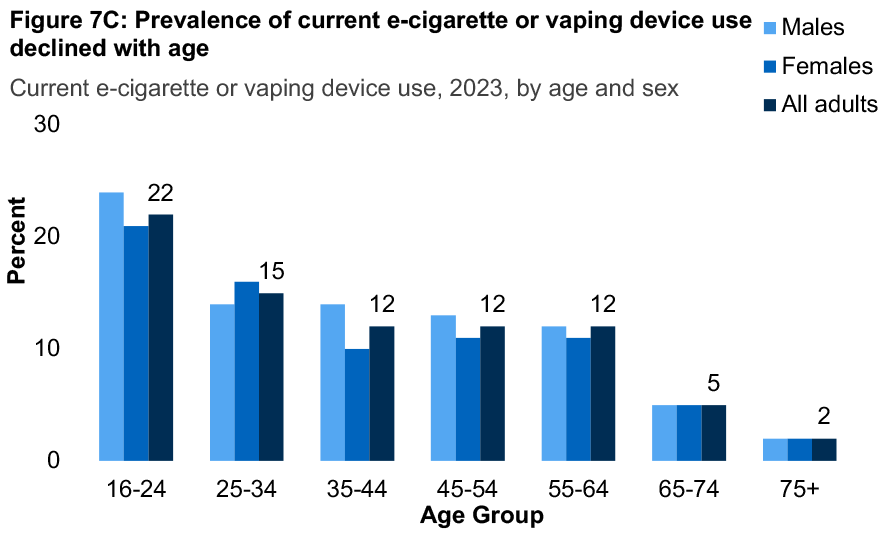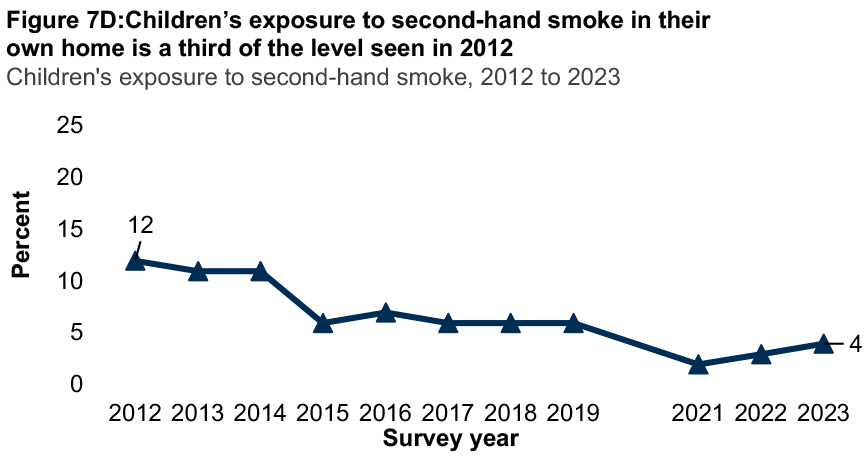The Scottish Health Survey 2023 - volume 1: main report
This report presents results for the Scottish Health Survey 2023, providing information on the health and factors relating to health of people living in Scotland.
7 Smoking
Hannah Biggs
7.1 Introduction
Tobacco is recognised internationally as a major public health threat. More than eight million deaths worldwide each year are a direct result of tobacco use, including an estimated 1.3 million non-smokers exposed to second-hand smoke[118].
Smoking is the cause of around one in five deaths[119] and a leading cause of premature death, ill health and disability in Scotland. Evidence of differences by deprivation in smoking rates and the likelihood that children will grow up in a smoking household/family or have a mother who smoked during pregnancy mean that smoking also remains an ongoing health inequality challenge[120],[121]. Smoking-related health risks increase over time but can be substantially reduced following smoking cessation interventions - cost-effective interventions that help to reduce the economic and human cost of smoking-related illnesses and conditions[122].
Less is known about the long-term impact of Nicotine Vapour Products (NVPs) (electronic cigarettes, vapes and all related equipment, including liquids). However, these practices and devices are not deemed to be risk-free, particularly where there is dual use alongside tobacco products[123],[124]. Further research to evaluate the long-term effects of NVPs is needed. While NVPs are deemed lower risk than tobacco products and can serve as a useful cessation aid, they can cause addiction to nicotine and health harms such as exposure to toxicants in non-smokers to which they would not otherwise have been exposed[125].
7.1.1 Policy background
The overall strategic objective for health in the Scottish Government’s National Outcomes Framework is ‘We are healthy and active’[126]. Scottish Health Survey (SHeS) data are used as a National Indicator to measure the proportion of adults with two or more of the following health risk behaviours: currently smoking, harmful/hazardous drinking, low physical activity and obesity[127].
Scottish Government’s new Tobacco and Vaping Framework: a roadmap to 2034[128], launched in November 2023, outlines interventions and policies that aim to ensure Scotland is raising a tobacco-free generation by 2034 (defined as ‘a smoking prevalence among the adult population of 5% or lower’). This includes working with the UK Government on their Smoke Free Generation by 2034 aims, further action on NVPs and measures to reduce the environmental impact of single use NVPs and to encourage responsible disposal[129].
7.1.2 Reporting on smoking in the Scottish Health Survey
This chapter presents data on:
- cigarette smoking and e-cigarette or vaping device use for adults
- smoking prevalence estimates for adults
- exposure to second-hand smoke for children and adults
- use of nicotine replacement therapy and other products
Figures are reported by age, sex and area deprivation.
The area deprivation data are presented in Scottish Index of Multiple Deprivation (SIMD) quintiles. To ensure that the comparisons presented are not confounded by the different age profiles of the quintiles, the data have been age-standardised. For a detailed description of both SIMD and age-standardisation, as well as definitions of other terminology used in this chapter and further details on the data collection methods for smoking, please refer to Chapter 2 of the Scottish Health Survey 2023- volume 2: technical report.
7.1.3 Comparability with other UK statistics
The Health Survey for England [130], Health Survey Northern Ireland[131] and the National Survey for Wales[132] provide estimates of smoking prevalence in the other UK countries. The surveys are conducted separately and have different sampling methodologies, so smoking prevalence estimates across the surveys are only partially comparable. Due to methodological changes during the pandemic, 2019 is the most recent partly comparable year of data for adult smoking.
Smoking prevalence estimates from the UK-wide Annual Population Survey (UK) and the Opinions and Lifestyle Survey GB provide fully comparable data for Scotland, England, Wales and Northern Ireland [133].
Further breakdowns for smoking can be found in the Scottish Survey Core Questions, which asks harmonised questions across the three major Scottish Government household surveys.
7.2 Results
Summary points
In 2023:
- Around one in seven (15%) adults were current smokers, the same proportion as in 2022. Smoking was least prevalent among those aged 75 and over (6%).
- Smoking prevalence was highest among adults living in the most deprived areas in Scotland (26%), and lowest among those living in the least deprived areas (6%).
- Twelve per cent of all adults were current e-cigarette or vaping device users, an increase from 10% in 2022. The proportion was highest for adults aged 16-24 (22%).
- Prevalence of current e-cigarette or vaping device use was highest among adults living in the most deprived areas of Scotland (17%), and lowest among those living in the least deprived areas (6%).
- The proportion of adults exposed to second-hand smoke in their own homes has reduced by 19 percentage points between 2003 (25%) and 2023 (6%).
- The proportion of children aged 0-15 exposed to second-hand smoke in their own homes was eight percentage points lower in 2023 (4%) than in 2012 (12%).
- Younger adults aged 16-24 were most likely to have used e-cigarettes or vaping devices in their most recent attempt to stop smoking, 44% compared with 3% of those aged 75 and over.
7.2.1 Around one in seven adults were current smokers in 2023
In 2023, 15% of all adults were current smokers, this is the same level as in 2022. Smoking was least prevalent among those aged 75 and over (6%), while for all other age groups, the current smoking rate was 15%-16%. While smoking prevalence was similar among males and females (16% and 13% respectively), significantly more females than males indicated that they had never smoked (66% and 59% respectively).
The mean number of cigarettes consumed per day was 11.1 for adult smokers, with no significant difference between males and females. The mean number of cigarettes consumed per day increased with age from 4.8 among 16-24 year olds up to a peak of 14.9 among those aged 65-74, before declining to 11.5 cigarettes per day for those aged 75 and over.

7.2.2 Cigarette smoking was highest among those living in the most deprived areas of Scotland in 2023
In 2023, smoking prevalence continued to be highest among adults living in the most deprived areas of Scotland (26%), and lowest among those living in the least deprived areas (6%).
In 2023, the mean number of cigarettes smoked per day was also highest among current smokers living in the most deprived areas (12.4 per day) and lowest among those living in the least deprived areas (8.7 per day).

7.2.3 E-cigarette or vaping device use was highest among those aged 16-24
In 2023, 12% of adults reported currently using e-cigarettes or vaping devices (compared to 10% in 2022), while 11% reported having previously used them.
In 2023, e-cigarette or vaping device use was most prevalent among those aged 16-24 (22%), an increase of seven percentage points since 2022 (15%) and least prevalent among those aged 75 and over (2%).
There was no significant difference in e-cigarette/vaping device use by sex.

7.2.4 E-cigarette or vaping device use was highest among adults living in the most deprived areas of Scotland
In 2023, the prevalence of e-cigarette or vaping device use was highest among adults living in the most deprived areas in Scotland (17%), and lowest among those living in the least deprived areas (6%). Similar patterns were observed for males and females. Table 7.4
7.2.5 The proportion of adults exposed to second-hand smoke in their own homes has fallen by 19 percentage points between 2003 and 2023
In 2023, 5% of adults were living in accommodation where someone smoked and 6% reported being exposed to second-hand smoke in their own/others’ homes. This was a decrease of 11 and 19 percentage points since 2003 (16% and 25% respectively). Table 7.5
7.2.6 Children’s exposure to second-hand smoke in their own home has decreased by 8 percentage points since 2012
In 2023, 8% of children aged 0-15 were living in accommodation in which someone smoked. The level reduced significantly from 19% in 2012 to between 4% and 8% in 2021 to 2023.
In 2023, a small proportion of children (4%) were exposed to second-hand smoke in their own home, an overall decrease of eight percentage points since 2012 (12%).

7.2.7 Younger adults were most likely to report use of e-cigarettes or vaping devices in their most recent attempt to stop smoking
In 2023, 40% of adult ex-smokers and current smokers who had ever attempted to quit smoking, had used some form of Nicotine Replacement Therapy (NRT) during their most recent attempt to quit. Use of NRT was highest for adults aged 16-24 (50%) and lowest for adults aged 75 and over (18%).
The most frequently used forms of NRT were nicotine gum, patches, nasal sprays/nicotine inhalers or lozenges/microtabs (24%), followed by e-cigarettes or vaping devices (21%).
The use of e-cigarettes or vaping devices in their most recent attempt to quit smoking was highest for adults aged 16-24 (44%) and decreased with age to a low of 3% among those aged 75 and over. Table 7.7
Notes
- Some caution should be exercised when interpreting data for 2021 within any time series data presented due to some methodological changes during the pandemic. Please see the 2022 Scottish Health Survey technical report for more information.
- Current cigarette smoker excludes those who reported only smoking cigars or pipes.
- Age-standardised data has been presented in sections 7.2.2 and 7.2.4.
Table list
Table 7.1 Cigarette smoking status, 2023, by age and sex
Table 7.2 Cigarette smoking status (age-standardised), 2023, by area deprivation and sex
Table 7.3 E-cigarette or vaping device use, 2023, by age and sex
Table 7.4 E-cigarette or vaping device use (age-standardised), 2023, by area deprivation and sex
Table 7.5 Non-smokers' exposure to second-hand smoke, 2003 to 2023, by sex
Table 7.6 Children's exposure to second-hand smoke, 2012 to 2023, by sex
Table 7.7 Use of nicotine replacement therapy (NRT) and other products, 2023, by age and sex
References and notes
1 World Health Organisation (2023). Tobacco. Available at: https://www.who.int/news-room/fact-sheets/detail/tobacco
3 Raising Scotland’s tobacco-free generation: our tobacco control action plan 2018.
Scottish Government (2018). Available at: https://www.gov.scot/publications/raising-scotlands-tobacco-free-generation-tobacco-control-action-plan-2018/
4 See: https://www.healthscotland.scot/health-topics/smoking/smoking-prevention
5 A guide to smoking cessation in Scotland. Edinburgh: NHS Scotland. (2017). Available at: http://www.healthscotland.scot/media/1097/helping-smokers-to-stop-smoking-2017.pdf
6 See: https://www.gov.scot/policies/smoking/electronic-cigarettes/
7 See: https://www.gov.scot/publications/vaping-health-harms-evidence-briefing/pages/4/
8 Scottish Government (2024). Vaping – Health harms: evidence briefing [online]. Available at: https://www.gov.scot/publications/vaping-health-harms-evidence-briefing/pages/4/
9 The National Performance Framework is described here: https://nationalperformance.gov.scot/
11 Tobacco and vaping framework: roadmap to 2034, Scottish Government (2023). Available at: https://www.gov.scot/publications/tobacco-vaping-framework-roadmap-2034/pages/3/
12 See: https://www.zerowastescotland.org.uk/resources/environmental-impact-single-use-e-cigarettes
13 See: https://digital.nhs.uk/data-and-information/publications/statistical/health-survey-for-england
14 See: https://www.nisra.gov.uk/statistics/find-your-survey/health-survey-northern-ireland
Contact
There is a problem
Thanks for your feedback